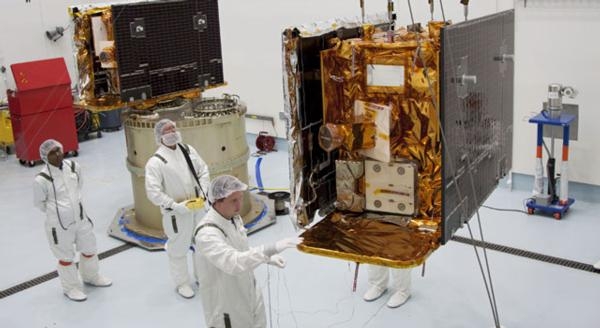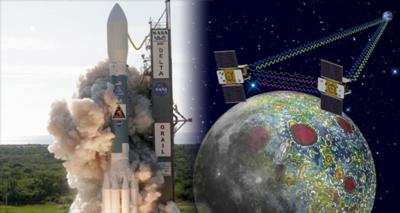Sun, Jan 01, 2012
First of NASA's GRAIL Spacecraft Starts Orbit
NASA has confirmed that the first of two NASA spacecraft to
study the moon in unprecedented detail has entered lunar orbit.
NASA's Gravity Recovery And Interior Laboratory (GRAIL)-A
spacecraft successfully completed its planned main engine burn at 2
p.m. PST (5 p.m. EST) today. As of 3 p.m. PST (6 p.m. EST), GRAIL-A
is in an orbit of 56 miles by 5,197 miles around the moon that
takes approximately 11.5 hours to complete.

"My resolution for the new year is to unlock lunar mysteries and
understand how the moon, Earth and other rocky planets evolved,"
said Maria Zuber, GRAIL principal investigator at the Massachusetts
Institute of Technology in Cambridge. "Now, with GRAIL-A
successfully placed in orbit around the moon, we are one step
closer to achieving that goal."
The next mission milestone occurs tomorrow when GRAIL-A's mirror
twin, GRAIL-B, performs its own main engine burn to place it in
lunar orbit. At 3 p.m. PST (6 p.m. EST) today, GRAIL-B was 30,018
miles from the moon and closing at a rate of 896 mph. GRAIL-B's
insertion burn is scheduled to begin tomorrow, Jan. 1, at 2:05 p.m.
PST (5:05 p.m. EST) and will last about 39 minutes.
"With GRAIL-A in lunar orbit we are halfway home," said David
Lehman, GRAIL project manager at NASA's Jet Propulsion Laboratory
in Pasadena, Calif. "Tomorrow may be New Year's everywhere else,
but it's another work day around the moon and here at JPL for the
GRAIL team."

Once both spacecraft are confirmed in orbit and operating,
science work will begin in March. The spacecraft will transmit
radio signals precisely defining the distance between them as they
orbit the moon in formation. As they fly over areas of greater and
lesser gravity caused by both visible features, such as mountains
and craters, and masses hidden beneath the lunar surface, the
distance between the two spacecraft will change slightly.
Scientists will translate this information into a high-resolution
map of the moon's gravitational field. The data will allow
scientists to understand what goes on below the lunar surface. This
information will increase knowledge of how Earth and its rocky
neighbors in the inner solar system developed into the diverse
worlds we see today.
JPL manages the GRAIL mission for NASA's Science Mission
Directorate at the agency's headquarters in Washington. The GRAIL
mission is part of the Discovery Program managed at NASA's Marshall
Space Flight Center in Huntsville, Ala. Lockheed Martin Space
Systems in Denver built the spacecraft.
More News
“While legendary World War II aircraft such as the Corsair and P-51 Mustang still were widely flown at the start of the Korean War in 1950, a new age of jets rapidly came to >[...]
Decision Altitude (DA) A specified altitude (mean sea level (MSL)) on an instrument approach procedure (ILS, GLS, vertically guided RNAV) at which the pilot must decide whether to >[...]
Aero Linx: National Aviation Safety Foundation (NASF) The National Aviation Safety Foundation is a support group whose objective is to enhance aviation safety through educational p>[...]
Also: Cal Poly Aviation Club, $$un Country, Arkansas Aviation Academy, Teamsters Local 2118 In response to two recent general aviation accidents that made national headlines, more >[...]
“The FAA is tasked with ensuring our skies are safe, and they do a great job at it, but there is something about the system that is holding up the medical process. Obviously,>[...]
 Aero-News: Quote of the Day (04.28.25)
Aero-News: Quote of the Day (04.28.25) ANN's Daily Aero-Term (04.28.25): Decision Altitude (DA)
ANN's Daily Aero-Term (04.28.25): Decision Altitude (DA) ANN's Daily Aero-Linx (04.28.25)
ANN's Daily Aero-Linx (04.28.25) Airborne-Flight Training 04.24.25: GA Refocused, Seminole/Epic, WestJet v TFWP
Airborne-Flight Training 04.24.25: GA Refocused, Seminole/Epic, WestJet v TFWP Aero-News: Quote of the Day (04.29.25)
Aero-News: Quote of the Day (04.29.25)




